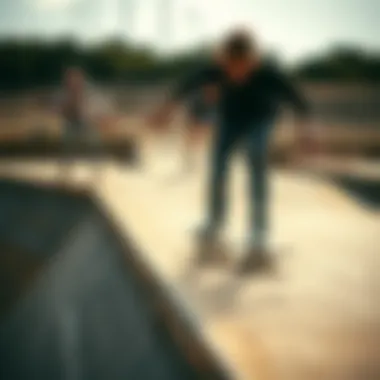Exploring the World of Mini Finger Boards


Intro
Mini finger boards, sometimes known as finger skateboards, have carved out a niche that’s rich in culture and creativity. While skateboarding has long been a rebellion on wheels, mini finger boards take this rebellion and condense it down to a size that fits perfectly into the palm of your hand. These tiny boards allow enthusiasts to experience the thrill of skateboarding without the need for a skatepark or even a cool breeze. As the world becomes increasingly digital, these small wooden planks offer a unique link to the physical and social aspects of a culture steeped in history.
Many might think that fingerboarding is just a child’s plaything, but there’s a surprising depth to this hobby. The precision with which one manipulates these boards can mirror that of full-caliber skateboarding, involving a blend of skills like balance, tricks, and creativity. The evolution of design in mini finger boards reflects broader trends within the skateboarding community — highlighting not just innovations but also the narratives that accompany them.
In this exploration, we’ll delve into the heart of mini finger boards. From their origins to the latest designs, we'll cover the gear that makes this niche pursuit so captivating as well as the technical skills needed to excel. Prepare to not just learn but also appreciate the artistry, craftsmanship, and community surrounding these miniature marvels.
Gear and Equipment
Mini finger boards come in a myriad of designs, materials, and technologies. Understanding what makes up this equipment is essential for both practitioners and aspiring fingerboarders.
- Decks: The foundation of the finger board, often made from multiple layers of wood or composite materials that mimic the feel of a real skateboard.
- Trucks: The metal component that connects the wheels to the deck. Many enthusiasts swear by brass or aluminum for enhanced durability and performance.
- Wheels: Materials and sizes of the wheels can greatly impact performance. Urethane wheels are favored for their grip and smooth ride, while harder plastics can offer varying degrees of speed.
Latest Design Innovations
The latest designs of mini finger boards showcase creativity and technology converging in exciting ways. 3D printing, for example, has opened the floodgates for custom shapes and sizes. Moreover, brands like Tech Deck and FlatFace have introduced unique grip tape and finishes that enhance both the aesthetic appeal and performance of these tiny boards.
"Fingerboarding is more than just a hobby; it's an art form that allows for personal expression without the restrictions of space or environment."
Essential Accessories for Every Fingerboarder
While the board itself is crucial, various accessories can enhance the overall experience.
- Grip Tape: Just like skateboards, grip tape on finger boards aids in control and trick performance.
- Carrying Cases: These protect the miniature equipment and help organize different boards and accessories.
- Miniature Obstacles: Items like ramps and ledges mimic the skate park experience and are essential for practicing tricks.
- Fingerboard Tools: These often include tools for adjusting trucks and wheels, ensuring optimum maneuverability.
Overall, having the right gear and accessories not only improves performance but also makes the learning journey far more enjoyable.
Techniques and Skills
The mastery of mini finger boards hinges on developing both fundamental and advanced techniques. Even for beginners, it’s essential to start with the basics before diving into complex tricks.
Beginner Techniques
When first starting with fingerboarding, mastering balance is key. Beginners typically begin with simple maneuvering, learning to roll the board back and forth. Once comfortable, transitioning to tricks like the ollie and kickflip can become a thrilling challenge.
- Ollie: A foundational trick that requires the rider to pop the tail down while pressing on the front with their finger to lift the board into the air.
- Flips: These moves require both finesse and timing, learning how to rotate the board beneath one's finger properly.
Advanced Maneuvers
As proficiency grows, so does the desire to tackle more complex tricks. Experienced fingerboarders often experiment with various combinations of flips and grinds, pushing the boundaries of what’s possible.
- Grinds: Sliding along edges using the trucks to maintain balance while executing flips simultaneously.
- Finger Flips: A tricky maneuver where the board is flipped in mid-air using fingers, showcasing a blend of finesse and dexterity.
The journey from novice to expert is often punctuated by experimentation and creativity, making fingerboarding a unique expression of personal skill and style.
For those looking to further explore finger boarding, numerous online forums and communities can offer valuable tips and tricks, such as reddit.com/r/fingerboarding. It's also worth checking out instructional videos on platforms like YouTube to visually grasp various techniques.
Prelude to Mini Finger Boards
Mini finger boards, while often overlooked, offer a unique glimpse into the world of alternative skateboarding. Their diminutive size and intricate designs resonate with both enthusiasts and novices alike. Understanding mini finger boards is not merely an exploration of a toy; it is diving into a cultural phenomenon that enriches communal interactions and personal skill development within the skateboarding community.
Importance of Mini Finger Boards
These small boards embody more than just a hobby; they are a canvas for creativity and mastery. The dexterity required to maneuver them mirrors the challenges faced on full-sized skateboards, yet they provide a more accessible way to practice tricks and skills, especially for those who may not have the space or ability to use larger boards. Mini finger boards can often be seen in various settings, from casual hangouts among friends to more serious training environments.
There’s a tactile charm in holding a mini finger board. The way it slides between fingers, catching angles of light, speaks to craftsmanship. Many enthusiasts appreciate the fine details in materials and designs—from the deck graphics to the unique trucks and wheels. Not only do they serve as an outlet for artistic expression, but they also foster a sense of community among their users.
In this article, we will cover several key themes surrounding mini finger boards, including their definition, historical context, design features, and cultural significance. This guide aims to dissect the multiple layers that make up the mini finger boarding world.
Defining Mini Finger Boards
Mini finger boards are miniature replicas of traditional skateboards, typically about 3-4 inches long. These pocket-sized boards have distinct features that replicate the functionalities of full-sized skateboards. Commonly, they come equipped with real working trucks, which allow for a range of tricks to be performed.
Essentially, these boards are designed to be manipulated by the fingers, using the dexterity of the fingers to perform tricks and maneuvers that mimic those seen on full-sized skateboards. The appeal lies in the challenge they present; while they might seem simple, executing a trick requires practice and precision.
The board itself is often made from a variety of materials, including wood, plastic, or even metal in some high-end models. Many aficionados customize their boards with unique art, grip tape patterns, and wheel selections, transforming each piece into a personal expression.


Historical Context
The journey of mini finger boards can be traced back to the late 20th century, coinciding with the rise of skateboarding culture. It gained significant traction during the early 1990s, inspired largely by the skateboarding boom and the popularity of toys like Tech Decks. These small boards drew not only from the aesthetics of skate culture but also from the tricks that could be seen on the streets.
Initially, mini finger boards were viewed as playful imitations of skateboards, yet they quickly evolved into a form of artistic expression and skill. As video gaming entered the scene, many fingerboard enthusiasts began incorporating digital tricks into their real-world practices. The integration of technology enhanced communities through online forums and social media platforms, allowing users to share tips, tricks, and designs.
Over the years, mini finger boards have transitioned from simple toys into serious tools for skill development and social interaction. The rise of specialized brands and communities further entrenched their status within skateboarding cultures, providing avenues for competition and camaraderie. Each historical milestone reflects not only the evolution of an item but the culture surrounding it, illustrating how something so small can create such massive waves in both skateboarding and recreational activities.
Design Features of Mini Finger Boards
The world of mini finger boards is intricately tied to their design features, which significantly influence performance, usability, and overall enjoyment for users. Understanding these design elements is crucial, as they can enhance the practice of tricks and techniques, offering unparalleled satisfaction to skaters. Specifically, the materials used, size considerations, and surface enhancements all play a vital role in the efficacy and appeal of these boards, creating a unique experience that transcends mere play.
Materials Used
When choosing a mini finger board, one must consider the materials that comprise its structure. Notably, the type of wood used can determine a board's durability, responsiveness, and weight. Most premium finger boards are constructed from layers of maple or birch wood, as these materials provide a robust yet flexible quality necessary for executing tricks.
- Maple Wood: Commonly used, it offers great strength without adding excessive weight.
- Bamboo: Known for its sustainability, bamboo boards tend to be lighter, making them easier for beginning skaters.
- Plastic: Available in lower-end models, plastic boards may lack the authenticity of wood but can be great for beginners and casual users.
Choosing the right material is not just about personal preference. It’s about how these choices affect durability and the kind of tricks that can be performed. For instance, heavier woods might offer more stability during complex flips, whereas lighter materials might be more suited to those just starting out.
Size and Scale Considerations
The size of a mini finger board can determine not only how it feels in hand but also how effectively one can learn and master different tricks. Typically, these boards range between 96mm to 105mm in length, though preferences can vary widely among users. Finding the right fit requires consideration of individual finger size and skill level.
Larger boards can provide better balance and stability, making them ideal for learners. In contrast, smaller boards offer more maneuverability, catering to pros working on intricate tricks. Here are some factors to consider regarding size:
- Finger Span: Bigger hands might find mini boards too cramped, while smaller fingers may struggle with larger boards.
- Trick Complexity: Advanced tricks often require precision, where a smaller board may shine, but challenges arise if the user is not accustomed to its size.
- Personal Preference: Ultimately, comfort in handling plays a huge role; what feels right varies from person to person, impacting skill progression.
Surface and Grip Enhancements
A mini finger board's performance is also highly affected by its surface and grip features. The deck's finish and grip tape can pivotally influence the skater's control and ability to perform tricks smoothly.
Generally, most finger boards come with grip tape applied to their surface, creating a textured feel that helps keep fingers secure during flips or slides. Enhancements in this regard often include:
- Silicone Grip: This can provide an enhanced feel, akin to riding a real skateboard.
- Foam Padding: Some boards integrate foam for cushioning, which can make landings smoother, though this feature may not be suitable for advanced skaters.
- Custom Graphics: Designs not only add personal flair; they can also incorporate materials that aid grip, making the visual aspect functional as well.
"Various grip enhancements can significantly elevate the fingerboarding experience, turning mundane tricks into an array of possibilities."
In summation, the design features of mini finger boards—ranging from material choice to size and grip—impact how enthusiasts approach their practice. A well-chosen board can act as a bridge between casual fun and serious skill development, creating engagement that resonates within the skating community.
Skill Development and Techniques
Skill development in mini finger boarding is not just about learning tricks; it's about fostering a deeper connection with this compact form of skateboarding. For many enthusiasts, it becomes a meditative practice, where the focus and concentration required lead to improved coordination and dexterity. Engaging with mini finger boards offers a multifaceted approach to enhancing fine motor skills, which are crucial not just for the activity itself but for other facets of life, as well.
Basic Fingerboard Tricks
Every journey begins with the basics. When first picking up a mini finger board, the initial focus should be on developing a good grip and understanding balance. The ollie, for instance, is a foundational trick that serves as the stepping stone for more complex maneuvers. This trick involves pressing down on the tail of the board to lift the front, allowing for a smooth jump. Mastering this is like learning the ABCs before writing essays—essential for any serious fingerboarder.
Another fundamental trick is the kickflip. Requires finesse, where the index finger drags across the board’s edge while the board is flicked with the thumb. This requires timing and precision, integrating both fingers in a seamless dance. Simple tricks like these form a repertoire that can be expanded upon, offering a sense of accomplishment as one progresses.
Advanced Maneuvers
Once the basics are tucked under the belt, it’s time to level up. Advanced fingerboarding maneuvers, such as grinds and slides, introduce a whole new element of creativity and expression free from gravity’s usual constraints. These tricks often take more practice as they require synchronization between both fingers and a keen understanding of angles and board dynamics.
A trick like the hardflip, where both the board flips and rotates, tests not just skill but also patience and perseverance. Each attempt begs the question: can the movement be smooth enough, quick enough? Some fingerboarders even blend dance-like movements into their routines, creating an artistic aspect that goes beyond raw athleticism.
Training Regimens for Precision
Developing a solid training regimen is crucial for precision and mastery. Consistency beats intensity—practicing a little every day is far more effective than cramming all at once.
Set out a structured schedule:
- Warm-up: Spend a few minutes just rolling the board to get comfortable.
- Focus Sessions: Different tricks per session, devoting 15-30 minutes to one or two tricks. Use a mirror or a camera to analyze form and techniques.
- Cool Down: Finish each session with some free riding, allowing creativity to flow without the pressure of executing tricks perfectly.
"Repetition is the mother of skill." – This mantra holds true in the world of fingerboarding. Eventually, the movements become second nature, and what was once a complex navigation of board dynamics morphs into an extension of one’s fingers.
Embracing this structured approach not only leads to greater skill but also elevates the sense of joy that comes from mastering something challenging, yielding personal satisfaction beyond the realm of competition.


Cultural Impact of Mini Finger Boards
The cultural significance of mini finger boards is a topic that extends far beyond their simple design and functionality. These small replicas of skateboards are not just toys; they represent a unique blend of skill, artistry, and community spirit. As they carve their niche in the world of recreation, it’s essential to explore how they fit into the larger fabric of skateboarding culture while enhancing social interaction among enthusiasts.
Integration into Skateboarding Culture
Mini finger boards act as a bridge into the broader skateboarding culture, providing an accessible means for newcomers to engage with the sport. These models often mirror the design and style of traditional skateboards, reflecting the aesthetics of the skateboarding lifestyle.
Many fingerboarders view their miniature boards as collectibles. High-quality brands, like Tech Deck and FlatFace Fingerboards, create intricate designs that mimic real-life brands. Collecting these boards becomes a point of pride, with enthusiasts often displaying them in elaborate ways, from artfully arranged shelves to display cases.
Moreover, mini finger board events, like exhibitions and competitions, promote social connectivity. They allow participants to showcase their skills in a supportive atmosphere. This interaction fosters camaraderie, and many friendships flourish from these shared interests.
Community and Social Dynamics
The community surrounding mini finger boards is rife with vibrant social dynamics. Online platforms such as Reddit and various Facebook groups offer dedicated spaces where enthusiasts can share tips, tricks, and their latest tricks. These communities are not just about competition; they serve as forums for inspiration and collaboration.
Collectively, enthusiasts often organize local meet-ups, where fingerboarders can gather to demonstrate skills, learn from each other, and engage in friendly competition. Such events often have a relaxed vibe, inviting enthusiasts of all skill levels to participate. After all, it’s not just about who can land the best trick—it’s about sharing a passion for the art of fingerboarding.
Men and women of various ages come together, breaking down barriers that can often be present in traditional sports. While skateboarding can sometimes seem exclusive, mini finger boards foster inclusivity, inviting everyone to share in the fun and creativity of the sport.
Competitive Fingerboarding
The competitive aspect of fingerboarding has grown over the years, drawing inspiration from traditional skateboarding competitions. Events like the Fingerboard World Championships bring together top talent from around the globe, creating a thrilling environment filled with camaraderie and sportsmanship. Participants often put hours of practice into perfecting their skills, demonstrating that dedication and perseverance are just as crucial in the mini format as in full-scale skateboarding.
Competitions not only highlight individual skill but also emphasize creativity. Fingerboarders employ unique styles, showcasing their personal flair through tricks and board designs, which in turn contribute to the broader culture and innovation within the community.
"Fingerboarding isn’t just about tricks; it’s a lifestyle, an art form, and often a way to connect with others who share the same passion."
In essence, mini finger boards transcend mere toys; they encapsulate the spirit of skateboarding’s aesthetic, fostering community and sparking innovation in a compact form. Understanding their cultural impact provides valuable insight into their growing significance within youth culture and sports.
For a deeper dive into the evolving nature of skateboarding and its impact, feel free to explore resources like Wikipedia or Britannica.
By appreciating the cultural dimensions of mini finger boards, enthusiasts can enrich their experience and understanding of this burgeoning hobby.
The Evolution of Mini Finger Boards
The world of mini finger boards has evolved significantly since their inception. This evolution is not merely about the physical boards themselves; it encapsulates a broader narrative of technological progression, cultural acceptance, and market dynamics. Understanding this evolution is crucial for grasping the full significance of mini finger boards in both the skateboarding community and beyond.
The journey of mini finger boards reflects changes in how we engage with hobbies and leisure activities. Early fingerboards were rudimentary, often crafted from scrap materials. Today, advancements in materials and design have transformed them into high-quality collectibles that bear resemblance to their full-sized counterparts. This transition speaks volumes about the dedication of the community and the innovation of manufacturers who are eager to meet the demands of an increasingly sophisticated audience.
Technological Advancements
The technological enhancements in mini finger boards are noteworthy. The shift from simplistic designs to highly engineered products illustrates a fascinating interplay of creativity and engineering.
- Materials: The introduction of lightweight yet durable materials like reinforced plastics and bamboo has redefined performance. Enthusiasts can now perform intricate tricks with a board that has both great stability and flexibility.
- Manufacturing Techniques: Precision craftsmanship has become a hallmark of modern mini finger boards. Many brands have adopted automated production methods that ensure consistency in quality, while also allowing for customization, such as personalized graphics and colors.
- Technological Integration: Some manufacturers have started to explore integrating technology into these boards. For instance, motion sensors could potentially track tricks and performance metrics, offering an exciting avenue for training and competitive preparation.
These advancements have not only improved the user experience but also attracted a new generation of enthusiasts who value precision and quality.
Market Trends and Popularity
Analyzing the market trends surrounding mini finger boards reveals a narrative of growing popularity. The current landscape showcases a mix of nostalgia, modern design sensibilities, and community-driven culture.
- Demographics: Originally perceived as a children’s toy, mini finger boards have found traction among teenagers and adults as well. This broadening demographic has led to deeper engagement within communities, spurring events, competitions, and social media challenges that promote fingerboarding skills.
- Community Building: Online platforms such as Reddit and Facebook have become vital nexuses for fingerboard enthusiasts. These spaces allow for sharing tricks, participating in discussions, and showcasing custom setups. Community-driven events like the "Fingerboard World Championship" have solidified fingerboarding’s cultural significance.
- Product Availability: There is a noteworthy increase in availability through online retailers and specialized skate shops. Brands like Tech Deck and flatface have established reputations, often selling out quickly due to high demand, which speaks volumes about their popularity.
"Mini finger boards represent more than just a hobby; they embody a culture that fuses creativity with community."
For more information on the cultural impact of skateboarding and its numerous subcultures, check resources like Britannica and Wikipedia.
Feel free to engage with others in communities like Reddit for discussions on techniques and product reviews.
Maintenance and Care
Maintaining mini finger boards is vital not just for their longevity but also for preserving their performance. Regular upkeep ensures that enthusiasts can engage in seamless tricks and maneuvers without interruptions. After all, a well-maintained fingerboard can provide an authentic skateboarding experience, reflecting the care invested in it. Moreover, keeping everything in top shape enhances the enjoyment factor, allowing both newbies and seasoned users to truly appreciate their craft.
Caring for these boards requires not only cleaning but also awareness of their unique features, including custom grip tapes and the quality of materials used. If you want to dive deeper, it's essential to recognize the skills involved in both the maintenance and performance aspects.
Cleaning Techniques


To keep a mini finger board performing well, regular cleaning is a must. Dirt, grease, or residual adhesive from grip tape can hamper your experience considerably. Here are a few effective techniques:
- Dusting Off: A soft cloth or a microfiber cloth works wonders. Gently wipe down the surface to remove any unnecessary grime.
- Cleaning Solution: A diluted mixture of soap and water can be applied using a soft brush. Avoid soaking the board, as excess water can damage the wood or metal components.
- Grip Tape Care: If the grip tape feels rough or sticky, sometimes a gentle scrub with a toothbrush can work magic. This rejuvenates the surface, making it super grippy once again.
- Utilizing Alcohol Wipes: A quick swipe with a rubbing alcohol wipe on both the deck and trucks can eliminate stubborn residues without damage.
"A clean board is a happy board. Keeping it spotless not just enhances its look but also its functionality."
Customization Options
Customization in mini finger boards is not merely a trend but a significant aspect of ownership. Personalizing these boards can reflect individual style, enhance performance, and even improve procedural comfort. Here are some popular customization options:
- Grip Tape: One of the first things owners often customize is the grip tape. Various designs and textures are available, allowing skaters to add their flair and ensure maximum traction.
- Wheels and Trucks: Experimenting with different wheel sizes, hardness, and colors can dramatically affect performance. Softer wheels provide more grip, while harder wheels are faster on smoother surfaces.
- Deck Shape: Some companies offer customizable deck shapes, catering to personal preferences of size and width. Changing the deck can also change the entire feel of the finger board.
- Stickers and Artwork: Doing up a finger board with stickers, paint, or decals represents a unique interpretation of one’s personality. Not only does this make the board look good, but for many, it’s a form of creative expression.
Investing time in both performing maintenance and exploring customization options can lead to a richer experience with mini finger boards. By prioritizing these aspects, users create not just a tool for fun and skill but a personal statement of identity and passion in the skateboarding culture.
Comparative Analysis
In the exploration of mini finger boards, it's critical to understand how they stack up against their full-sized counterparts. This comparative analysis sheds light on not just the physical distinctions but also the unique experiences that each type provides. By analyzing these elements, enthusiasts and newcomers alike can make informed decisions tailored to their personal preferences and skill levels.
Mini Finger Boards vs. Full-Sized Boards
When you put a mini finger board next to a full-sized skateboard, at first glance, it may seem like comparing apples to oranges. However, both share the same core essence of skateboarding—style, technique, and a culture of rebellion. The differences lie in functionality and approach.
- Size & Portability: Mini finger boards are roughly a fraction of the size of a regular skateboard. Their compactness allows for easy storage and transport, appealing to those who enjoy small-scale tricks in confined spaces. It's not uncommon for a rider to slip a mini finger board into their pocket for bouts of practice in coffee shops or at the park.
- Skill Expression: While full-sized boards are favored for larger, more complex tricks (think of ollies or grinds), mini finger boards allow for a microscopic perspective on trick manipulation. Riders can replicate real-world skateboarding moves with remarkable precision, turning simple finger movements into a beautiful dance of agility.
- Target Audience: Full-sized boards attract a more diverse array of skaters from exuberant youth to seasoned pros; mini finger boards, however, tend to capture a niche audience. Many enthusiasts are drawn in by their childhood nostalgia or a casual holiday gift that later sparks a new obsession. The accessibility of fingerboards often democratizes the art of skateboarding, enabling even those with limited mobility or expertise to partake in the culture.
"Mini finger boards unlock a world of tricks and creativity that resonate with both young kids and adults, presenting a unique path to engage with skateboarding without needing a full skatepark."
User Experiences Across Demographics
The world of mini finger boards is rich with diverse experiences that cut across various demographic lines. Understanding these can illuminate not just preferences but also cultural relevance.
- Age Groups: Younger users often slide their mini finger boards across desks or coffee tables while attempting to master flip tricks. Adults, especially those who grew up skating in the 90s, may find themselves reliving memories and honing their skills during their breaks at work. Anecdotes abound about office desks transforming into makeshift skateparks, fostering a sense of nostalgia.
- Cultural Influence: The impact of social media cannot be understated here. Platforms like Reddit and Instagram have created a community where users of all ages share their fingerboarding experiences. Older skaters provide mentorship and tips to the younger generation, creating a supportive circle of learning and exchange.
- Learning Styles: Some individuals thrive on hands-on learning, allowing trial and error to guide their fingerboarding journey. Others prefer watching online tutorials or participating in community workshops to refine their techniques. This variance in learning approaches illustrates how mini finger boards encourage different facets of skill development.
An in-depth evaluation of these user experiences reveals that mini finger boards not only serve as a fun pastime but also play a pivotal role in bridging generational gaps within skateboarding culture.
Future Trends and Innovations
In today's world, mini finger boards stand on the precipice of exciting transformations. This section dives into what lies ahead for this unique niche, focusing on specific elements like sustainability and technological innovations. The relevance of these trends cannot be overstated; they shape the products available and influence the community of users who engage with them. As consumers become more eco-conscious and tech-savvy, manufacturers must pivot to accommodate these advancing demands.
Sustainability in Manufacturing
Sustainability is no longer a mere buzzword. In the realm of mini finger boards, it is becoming a crucial aspect of production. Fingerboarding enthusiasts are increasingly favoring brands that reflect their values, particularly concerning environmental conservation. Companies are moving away from traditional materials, such as plastic, towards sustainable alternatives. For example, bamboo and recycled wood have started making a splash in fingerboard design. Not only do these materials reduce waste, but they also provide a unique aesthetic appeal.
- Benefits of Sustainable Materials:
- Less Environmental Impact: Using materials like bamboo means less deforestation and reduced carbon footprints.
- Durability: Eco-friendly options can sometimes outperform their synthetic counterparts in longevity.
- Market Differentiation: Brands adopting sustainability tend to resonate well with many consumers today, positioning themselves as leaders in the market.
However, the journey toward sustainability doesn't end with material choice. Manufacturing processes are also under scrutiny. Factories are making strides in reducing waste and energy consumption. Moreover, some businesses are introducing a circular economy model, allowing users to return old boards for refurbishment or recycling. This approach not only fosters consumer connection but also reinforces a sense of community centered around environmental responsibility.
Emerging Technologies and Design
As technology continues to evolve, the fingerboarding world is not lagging behind. Emerging technologies are paving the way for innovative designs that enhance user experience. Think of the endless possibilities that 3D printing offers. This technology allows for customized designs, catering to individual preferences in shape, size, and art. Beyond that, digital platforms are transforming how enthusiasts learn the tricks of the trade.
- Innovative Features in Finger Board Design:
- Smart Fingerboards: These can connect to apps that track progress or provide tutorials on complex tricks.
- Adjustable Decks: Some companies are experimenting with modular designs, letting users adapt their boards for various tricks or riding styles.
- Augmented Reality (AR): Future designs may incorporate AR for interactive learning experiences, enabling riders to visualize techniques in a three-dimensional space.
The road ahead not only embraces cutting-edge technology but also enhances the emotional connection enthusiasts feel toward their gear. These innovations are not just trends; they reflect a shifting paradigm that values customization, interactivity, and sustainability.
"Innovation shouldn’t be a one-off experience. It should be a culture. For mini finger boards, this culture integrates eco-consciousness and tech-savvy designs that resonate with today’s passionate riders."
In summary, the future of mini finger boards is bright, marked by a commitment to sustainability and the adoption of emerging technologies. For surfers, outdoor enthusiasts, and travel bloggers alike, these developments not only promise a better product but also a more engaging and responsible community.
Epilogue
The exploration of mini finger boards reveals not just toys for casual fun, but a deep-rooted culture that reflects the aspirations and trends within the skateboarding community. The topic of mini finger boards deserves attention for a multitude of reasons, ranging from their historical significance to their role in fostering community.
Summary of Key Insights
- Cultural Legacy: Mini finger boards emerged from the broader skateboarding culture, tracing their roots back to the 1980s. They embody a spirit of creativity and innovation, where enthusiasts express themselves not only through physical maneuvers but also by customizing their setups.
- Technical Aspects: The intricacies involve materials like maple wood, plastic, and various grip tapes that elevate the performance of these models. Size and scale considerations play a significant role, catering to individuals with varying preferences and skill levels.
- Community Dynamics: They serve as a bridge connecting diverse demographics—youths, adults, and even seasoned skaters. Competitive events inject excitement into this niche while fostering a sense of camaraderie among participants.
- Future of the Craft: Sustainability in manufacturing represents a forward-thinking approach to production. Emerging technologies such as 3D printing could innovate the design further, offering personalized experiences to avid fans.
Final Thoughts on Mini Finger Boards
Mini finger boards have transcended their original purpose of just being a toy. They are now intricately woven into the fabric of skateboarding culture, serving as tools for practice, socialization, and creative expression. As we look ahead, the innovations beckon a promising future that aligns with modern values of sustainability and community engagement. Whether you are a novice trying to master your first trick or a seasoned aficionado perfecting complex maneuvers, mini finger boards offer a unique niche that continues to evolve. In this ever-changing landscape, they stand out as a testament to the enduring spirit of skateboarding, proving that sometimes, the smallest instruments can create the loudest impacts.







